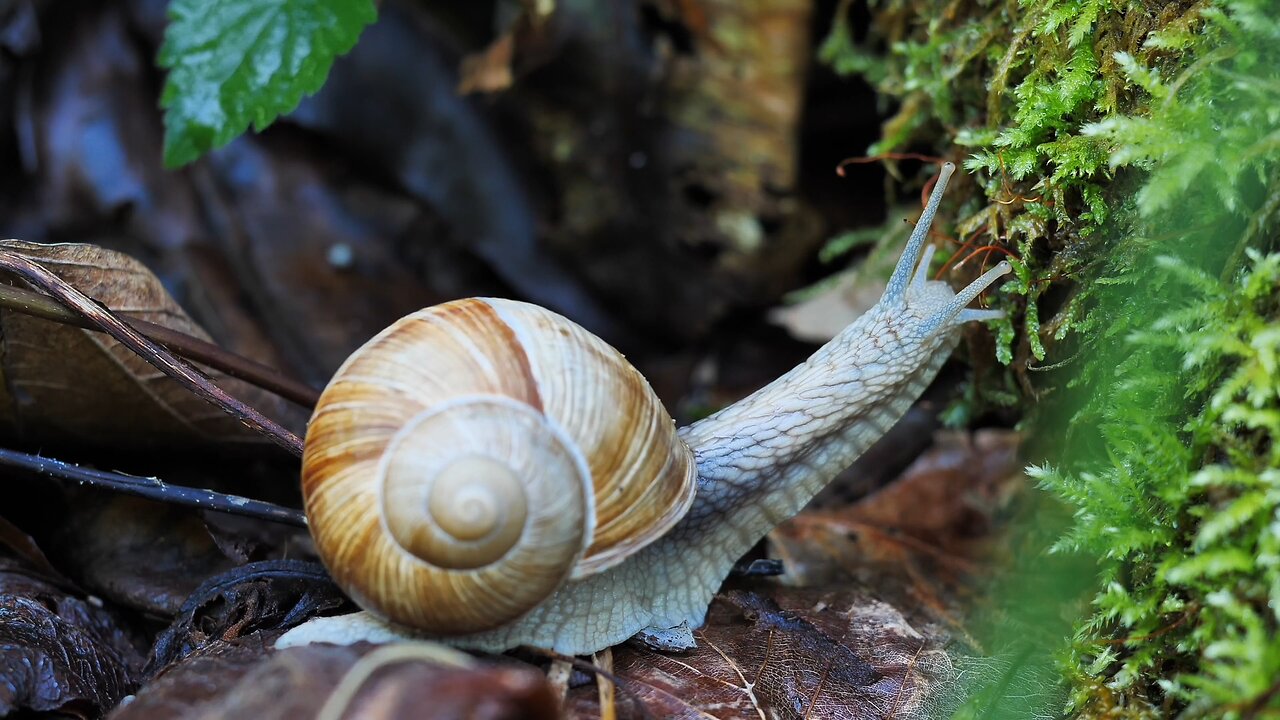Premium Only Content

"The Snail's Journey: A Look into Gastropod Life"
Snails are slow-moving mollusks that belong to the class Gastropoda. They are known for their coiled shells, which they carry on their backs. Snails can be found in a wide variety of environments, including land, freshwater, and marine habitats.
### Key Features:
- **Shell:** The most recognizable feature of a snail is its shell, which serves as protection against predators and harsh environmental conditions. The shell is usually spiral-shaped and can vary greatly in size and color depending on the species.
- **Body:** Snails have a soft, unsegmented body. They move using a muscular "foot" that secretes mucus, allowing them to glide across surfaces. This mucus also helps reduce friction and can protect the snail from sharp objects.
- **Tentacles:** Snails have two pairs of tentacles on their head. The longer pair typically has eyes at the tips, while the shorter pair is used for sensing their surroundings.
### Types of Snails:
- **Land Snails:** These snails are found on land and are commonly seen in gardens, forests, and fields. They are mostly herbivorous, feeding on plants, leaves, and fruits.
- **Freshwater Snails:** These snails live in ponds, lakes, rivers, and streams. They often feed on algae and plant material.
- **Marine Snails:** Found in the ocean, these snails can live in various marine environments, from shallow coastal waters to the deep sea.
### Behavior and Diet:
- **Movement:** Snails are known for their slow movement, which is why the term "snail's pace" is used to describe something very slow.
- **Feeding:** Most snails are herbivores, but some are omnivores or carnivores. They use a radula, a specialized feeding organ, to scrape or cut food into small pieces.
### Reproduction:
Snails are usually hermaphrodites, meaning they have both male and female reproductive organs. However, they typically still need a mate to reproduce. After mating, snails lay eggs in moist, protected environments.
### Importance:
- **Ecological Role:** Snails play an important role in the ecosystem as decomposers, helping to break down organic material. They are also a key food source for many animals, including birds, mammals, and insects.
- **Human Impact:** Snails are sometimes considered pests in agriculture and gardening because they can damage crops and plants. However, they are also valued in some cultures as a food delicacy, especially in dishes like escargot.
Snails are fascinating creatures with a unique biology and significant ecological roles, making them an interesting subject of study and appreciation.
-

Vigilant News Network
21 hours agoHillary Clinton EXPOSED In Another Massive Hoax | The Daily Dose
68.1K38 -
 1:00:17
1:00:17
Trumpet Daily
1 day ago $7.53 earnedRINOs Are Trump’s Biggest Enemy Now - Trumpet Daily | Nov. 22, 2024
17.3K24 -
 17:47
17:47
RealReaper
15 hours ago $0.68 earnedGladiator 2 Another Pointless Sequel
10.6K4 -
 45:45
45:45
PMG
14 hours ago $0.49 earned"Hannah Faulkner and Stephanie Nash | No Farms No Food"
8.7K1 -
 27:11
27:11
Degenerate Plays
1 day ago $0.30 earnedReturn Of The Online Girlfriends - Stellar Blade : Part 30
7.24K1 -
 7:16
7:16
SeasonofMist
2 days agoSOLSTAFIR - Fjara (Official Music Video)
5.8K3 -
 3:54
3:54
Good Kid Productions
9 days agoTrump just broke legacy media. We're building something better.
3.74K1 -
 3:13:17
3:13:17
Boxin
8 hours ago(Rumble push to 50 Followers!) (alerts Working...?) Spoopy Month!!!! Resident Evil 7 Biohazard 4
76.5K3 -
 2:26:35
2:26:35
Father Russell
8 hours agoThrone and Liberty | Morning Stream
44.7K1 -
 5:59:12
5:59:12
ColdHe4rted
13 hours agoOverwatch = new tank! Lets go!
33.3K1